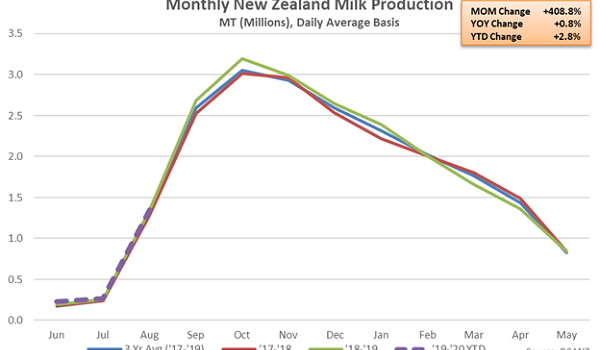
New Zealand Milk Production Update – Sep ’19
Executive Summary
New Zealand milk production figures provided by Dairy Companies Association of New Zealand (DCANZ) were recently updated with values spanning through Aug ’19. Highlights from the updated report include:
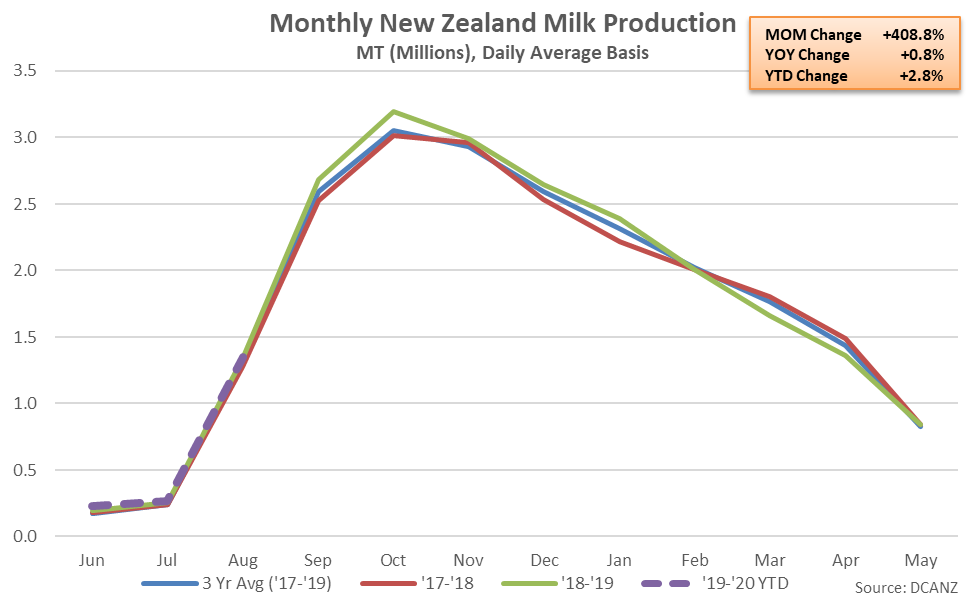 ’18-’19 annual New Zealand milk production volumes increased 2.2% YOY, finishing at a four year high level but remaining 2.4% below the record high production levels experienced throughout the ’14-’15 production season. Nearly ideal weather conditions were experienced throughout the early months of the ’18-’19 production season, contributing to significant increases in milk production volumes experienced throughout the New Zealand seasonal flush months, however hot, dry weather conditions experienced across New Zealand tempered production growth rates over the final months of the production season.
’19-’20 YTD New Zealand milk production volumes have increased an additional 2.8% on a YOY basis throughout the first quarter of the production season and are on pace to reach a record high annual level. The first quarter of the New Zealand milk production season has accounted for just 7.6% of annual milk production volumes on average over the past ten years, however. New Zealand milk production volumes will increase seasonally until highs are experienced throughout the month of October.
’18-’19 annual New Zealand milk production volumes increased 2.2% YOY, finishing at a four year high level but remaining 2.4% below the record high production levels experienced throughout the ’14-’15 production season. Nearly ideal weather conditions were experienced throughout the early months of the ’18-’19 production season, contributing to significant increases in milk production volumes experienced throughout the New Zealand seasonal flush months, however hot, dry weather conditions experienced across New Zealand tempered production growth rates over the final months of the production season.
’19-’20 YTD New Zealand milk production volumes have increased an additional 2.8% on a YOY basis throughout the first quarter of the production season and are on pace to reach a record high annual level. The first quarter of the New Zealand milk production season has accounted for just 7.6% of annual milk production volumes on average over the past ten years, however. New Zealand milk production volumes will increase seasonally until highs are experienced throughout the month of October.
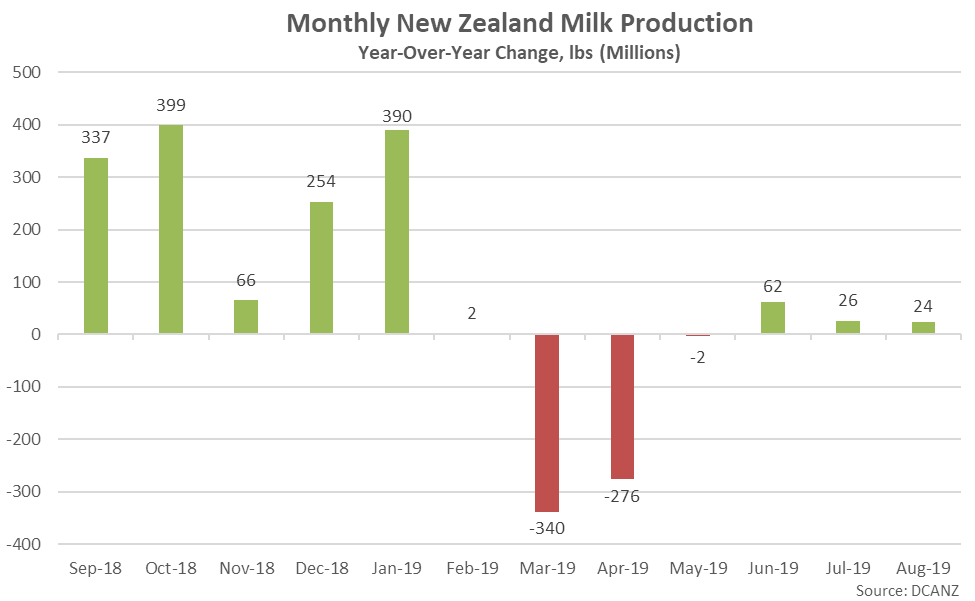 New Zealand milk production volumes increased at a compound annual growth rate of 4.2% over the ten year period ending during the ’14-’15 record production season but have trended flat-to-lower over the four most recent production seasons as farmgate milk prices declined from the ’13-’14 record high levels and the New Zealand milk cow herd was reduced. USDA is projecting the New Zealand milk cow herd will rebound slightly on a YOY basis throughout 2019, however, increasing 0.1% to a four year high level.
New Zealand milk production volumes increased at a compound annual growth rate of 4.2% over the ten year period ending during the ’14-’15 record production season but have trended flat-to-lower over the four most recent production seasons as farmgate milk prices declined from the ’13-’14 record high levels and the New Zealand milk cow herd was reduced. USDA is projecting the New Zealand milk cow herd will rebound slightly on a YOY basis throughout 2019, however, increasing 0.1% to a four year high level.
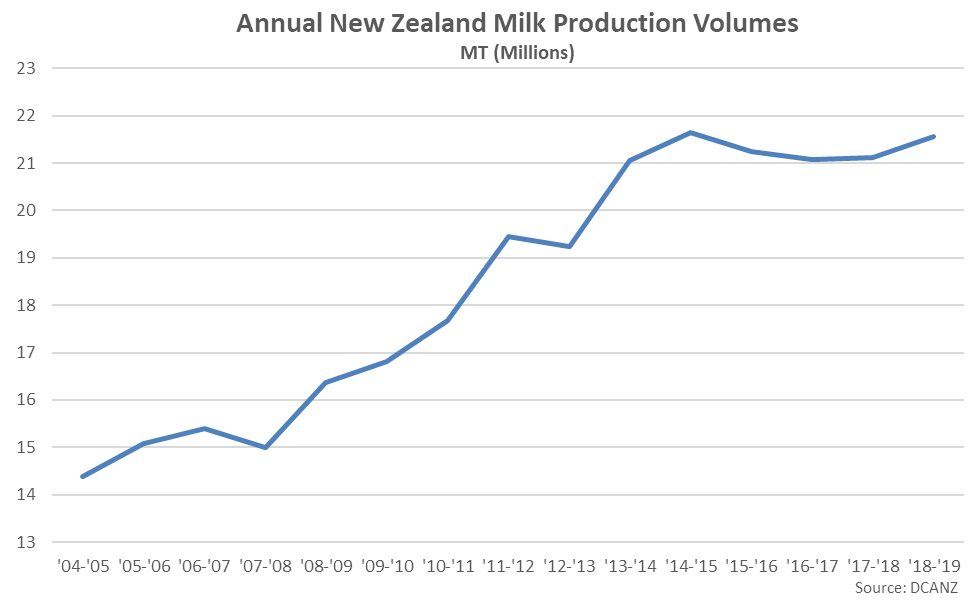 Farmgate Milk Prices
Fonterra farmgate milk prices reached a nine year low during the ’15-’16 production season as concerns over a potential El Niño event mounted while global milk supplies expanded significantly, particularly from within the EU-28. Fonterra farmgate milk prices rebounded throughout the ’16-’17 and ’17-’18 production seasons as a gradual rebalancing of global supply and demand took place, while Fonterra’s current ’18-’19 farmgate milk price forecast of $6.30-$6.40/kgMS is expected to remain above break-even levels but finish below the four year high levels experienced throughout the previous production season. The midpoint of Fonterra’s ’19-’20 opening farmgate milk price forecast of $6.25-$7.25/kgMS would be a six year high, however, as demand is expected to remain strong across key trading partners.
Farmgate Milk Prices
Fonterra farmgate milk prices reached a nine year low during the ’15-’16 production season as concerns over a potential El Niño event mounted while global milk supplies expanded significantly, particularly from within the EU-28. Fonterra farmgate milk prices rebounded throughout the ’16-’17 and ’17-’18 production seasons as a gradual rebalancing of global supply and demand took place, while Fonterra’s current ’18-’19 farmgate milk price forecast of $6.30-$6.40/kgMS is expected to remain above break-even levels but finish below the four year high levels experienced throughout the previous production season. The midpoint of Fonterra’s ’19-’20 opening farmgate milk price forecast of $6.25-$7.25/kgMS would be a six year high, however, as demand is expected to remain strong across key trading partners.
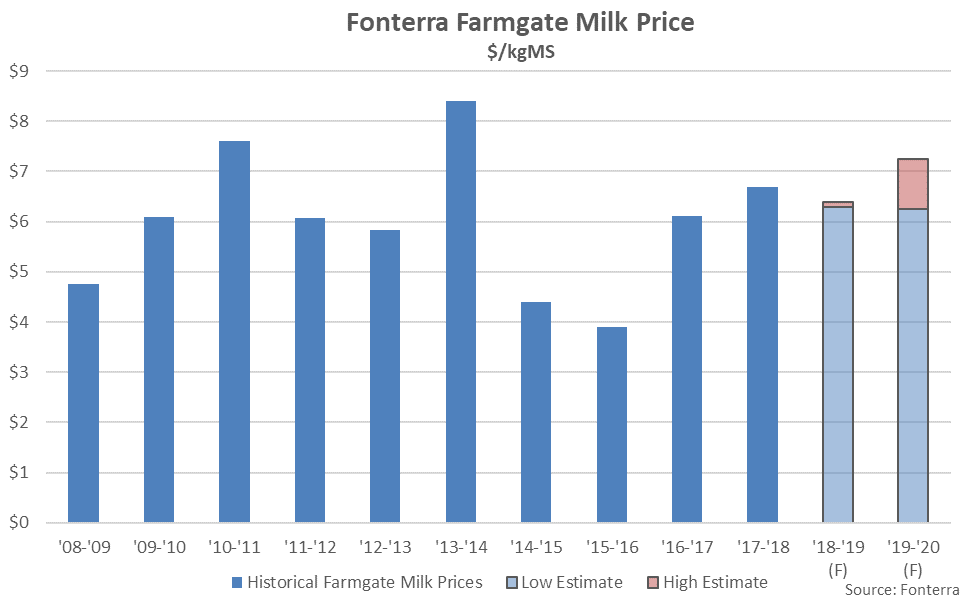 Cow & Heifer Slaughter
Jul ‘19 New Zealand cow & heifer slaughter rates finished 10.7% higher YOY when normalizing for slaughter days, reaching a 15 year seasonal high level for the month of July. The Jul ’19 YOY increase in New Zealand cow & heifer slaughter rates was the first experienced throughout the past four months. Jul ‘19 dairy cow & heifer slaughter, which has more limited historical data available, also increased on a YOY basis for the first time in the past four months, finishing up 18.3%. ’18-’19 annual New Zealand cow & heifer slaughter rates declined 0.7% YOY while finishing 2.3% below three year average figures.
Cow & Heifer Slaughter
Jul ‘19 New Zealand cow & heifer slaughter rates finished 10.7% higher YOY when normalizing for slaughter days, reaching a 15 year seasonal high level for the month of July. The Jul ’19 YOY increase in New Zealand cow & heifer slaughter rates was the first experienced throughout the past four months. Jul ‘19 dairy cow & heifer slaughter, which has more limited historical data available, also increased on a YOY basis for the first time in the past four months, finishing up 18.3%. ’18-’19 annual New Zealand cow & heifer slaughter rates declined 0.7% YOY while finishing 2.3% below three year average figures.
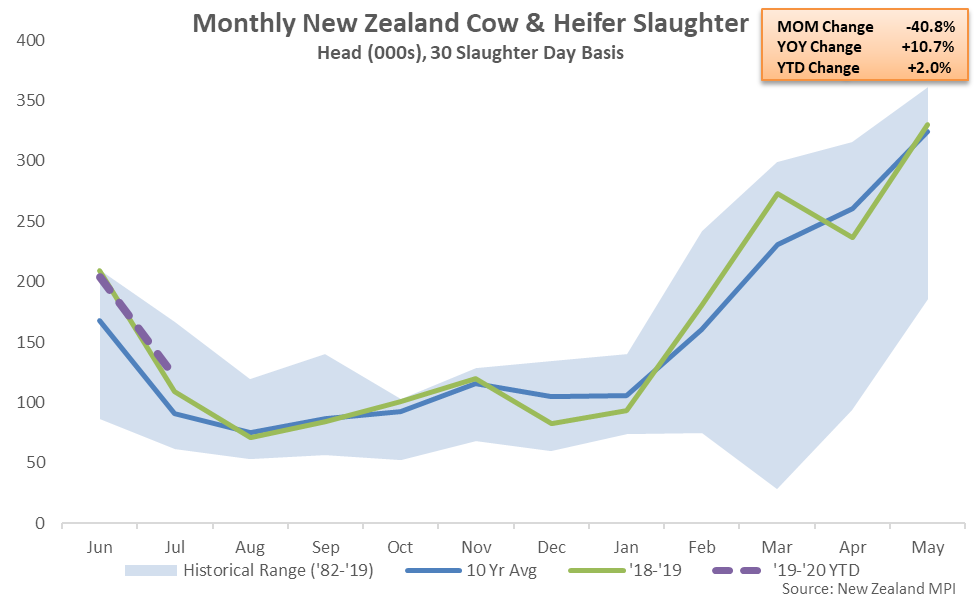
- Aug ’19 New Zealand milk production volumes increased 0.8% on a YOY basis, reaching a record high seasonal level. The YOY increase in New Zealand milk production volumes was the third experienced in a row.
- Fonterra’s ’18-’19 farmgate milk price forecast of $6.30-$6.40/kgMS is expected to finish below the four year high levels experienced throughout the previous production season. The midpoint of Fonterra’s ’19-’20 opening farmgate milk price forecast of $6.25-$7.25/kgMS would be a six year high, however, as demand is expected to remain strong across key trading partners.
- Jul ’19 New Zealand cow & heifer slaughter rates increased 10.7% YOY when normalizing for slaughter day, reaching a 15 year seasonal high level for the month of July. The Jul ’19 YOY increase in slaughter rates was the first experienced throughout the past four months.
 ’18-’19 annual New Zealand milk production volumes increased 2.2% YOY, finishing at a four year high level but remaining 2.4% below the record high production levels experienced throughout the ’14-’15 production season. Nearly ideal weather conditions were experienced throughout the early months of the ’18-’19 production season, contributing to significant increases in milk production volumes experienced throughout the New Zealand seasonal flush months, however hot, dry weather conditions experienced across New Zealand tempered production growth rates over the final months of the production season.
’19-’20 YTD New Zealand milk production volumes have increased an additional 2.8% on a YOY basis throughout the first quarter of the production season and are on pace to reach a record high annual level. The first quarter of the New Zealand milk production season has accounted for just 7.6% of annual milk production volumes on average over the past ten years, however. New Zealand milk production volumes will increase seasonally until highs are experienced throughout the month of October.
’18-’19 annual New Zealand milk production volumes increased 2.2% YOY, finishing at a four year high level but remaining 2.4% below the record high production levels experienced throughout the ’14-’15 production season. Nearly ideal weather conditions were experienced throughout the early months of the ’18-’19 production season, contributing to significant increases in milk production volumes experienced throughout the New Zealand seasonal flush months, however hot, dry weather conditions experienced across New Zealand tempered production growth rates over the final months of the production season.
’19-’20 YTD New Zealand milk production volumes have increased an additional 2.8% on a YOY basis throughout the first quarter of the production season and are on pace to reach a record high annual level. The first quarter of the New Zealand milk production season has accounted for just 7.6% of annual milk production volumes on average over the past ten years, however. New Zealand milk production volumes will increase seasonally until highs are experienced throughout the month of October.
 New Zealand milk production volumes increased at a compound annual growth rate of 4.2% over the ten year period ending during the ’14-’15 record production season but have trended flat-to-lower over the four most recent production seasons as farmgate milk prices declined from the ’13-’14 record high levels and the New Zealand milk cow herd was reduced. USDA is projecting the New Zealand milk cow herd will rebound slightly on a YOY basis throughout 2019, however, increasing 0.1% to a four year high level.
New Zealand milk production volumes increased at a compound annual growth rate of 4.2% over the ten year period ending during the ’14-’15 record production season but have trended flat-to-lower over the four most recent production seasons as farmgate milk prices declined from the ’13-’14 record high levels and the New Zealand milk cow herd was reduced. USDA is projecting the New Zealand milk cow herd will rebound slightly on a YOY basis throughout 2019, however, increasing 0.1% to a four year high level.
 Farmgate Milk Prices
Fonterra farmgate milk prices reached a nine year low during the ’15-’16 production season as concerns over a potential El Niño event mounted while global milk supplies expanded significantly, particularly from within the EU-28. Fonterra farmgate milk prices rebounded throughout the ’16-’17 and ’17-’18 production seasons as a gradual rebalancing of global supply and demand took place, while Fonterra’s current ’18-’19 farmgate milk price forecast of $6.30-$6.40/kgMS is expected to remain above break-even levels but finish below the four year high levels experienced throughout the previous production season. The midpoint of Fonterra’s ’19-’20 opening farmgate milk price forecast of $6.25-$7.25/kgMS would be a six year high, however, as demand is expected to remain strong across key trading partners.
Farmgate Milk Prices
Fonterra farmgate milk prices reached a nine year low during the ’15-’16 production season as concerns over a potential El Niño event mounted while global milk supplies expanded significantly, particularly from within the EU-28. Fonterra farmgate milk prices rebounded throughout the ’16-’17 and ’17-’18 production seasons as a gradual rebalancing of global supply and demand took place, while Fonterra’s current ’18-’19 farmgate milk price forecast of $6.30-$6.40/kgMS is expected to remain above break-even levels but finish below the four year high levels experienced throughout the previous production season. The midpoint of Fonterra’s ’19-’20 opening farmgate milk price forecast of $6.25-$7.25/kgMS would be a six year high, however, as demand is expected to remain strong across key trading partners.
 Cow & Heifer Slaughter
Jul ‘19 New Zealand cow & heifer slaughter rates finished 10.7% higher YOY when normalizing for slaughter days, reaching a 15 year seasonal high level for the month of July. The Jul ’19 YOY increase in New Zealand cow & heifer slaughter rates was the first experienced throughout the past four months. Jul ‘19 dairy cow & heifer slaughter, which has more limited historical data available, also increased on a YOY basis for the first time in the past four months, finishing up 18.3%. ’18-’19 annual New Zealand cow & heifer slaughter rates declined 0.7% YOY while finishing 2.3% below three year average figures.
Cow & Heifer Slaughter
Jul ‘19 New Zealand cow & heifer slaughter rates finished 10.7% higher YOY when normalizing for slaughter days, reaching a 15 year seasonal high level for the month of July. The Jul ’19 YOY increase in New Zealand cow & heifer slaughter rates was the first experienced throughout the past four months. Jul ‘19 dairy cow & heifer slaughter, which has more limited historical data available, also increased on a YOY basis for the first time in the past four months, finishing up 18.3%. ’18-’19 annual New Zealand cow & heifer slaughter rates declined 0.7% YOY while finishing 2.3% below three year average figures.
